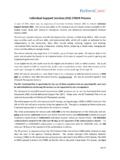Transcription of “Managing Transitions” by William Bridges
1 managing Transitions . by William Bridges Brief summary of key points Change vs. transition (pg. 4). Change is situational and happens without people transitioning transition is psychological and is a 3 phase process where people gradually accept the details of the new situation and the changes that come with it New Ending Beginning Enthusiasm Denial Shock Hope Importance Anger Frustration/ Acceptance Stress Ambivalence Skepticism Neutral Zone FAST transition IS. G E I S SLOW. CHAN. Interventions to Help transition ( ). Communicate individual behavior change Identify & understand who will lose what Sell the problem Get employees in touch with clients Talk to employees and ask what problems they have with the change Talk about the transition and let people know its human to feel Hold regular team meetings even before the change Do's and Don'ts of managing Transitions ( ).
2 DO: Rewards/Compensation Implement temporary systems until cutover Use ambiguity to continuously improve Make group space changes Use symbolic logo Benchmark 1st hand Offer a comprehensive training plan with a motivational speaker Develop a change manager role DON'T: Explain change through a memo or org chart Turn change over to an individual contributor and ask them to develop the whole plan Break change into smaller stages Pull a model team together to show others how Make threats Communicating During transition ( ). Don't rationalize not communicating The grapevine already has the news You told them once but it won't sink in Supervisors are in transition themselves- don't rely on trickle- down communication Say what you know, say what you don't know and commit to a time to give them more information Considering Endings Consider what they are letting go of: How happy are they with the way things are?
3 What behaviors are being rewarded now that will change or need to change? How can we get employees to embrace the change, eliminate their fear and develop a new identity and sense of purpose in it? What communication and strategies are needed to get them there? Encouraging Endings (pg. 25). When encouraging people to let go : Describe change in as much detail as possible Identify the ripple effects of change Identify who has to let go of what Notice intangible losses Notice whether there's something over for everyone Endings- Accept Subjective Losses ( ). Acknowledge losses openly and sympathetically! If you don't it will stop open dialogue and you won't learn more from them Loss is subjective, your point of view is irrelevant They'll think you don't care about what they think or feel if you force your opinion Mark the Endings ( ).
4 The last thing a company needs is an incomplete ending that requires a whole new round of losses to finish the job before people have had time to heal! This is the first task of transition management Endings- Respect the Past ( ). Don't ridicule the past. It negates people's self worth. Position the past as a positive legacy that paved the way for the new Don't stamp out the past like an infection Let people take something with them Dangers of Neutral Zones ( ). Anxiety rises & motivation falls. People become: Resentful and protective Self-doubting Less productive Absent more often People are overloaded, mixed signals and confusion are high, important tasks go undone, turnover is high People become polarized- some rush forward, others stay back and hang on Old weaknesses re-emerge The organization becomes vulnerable to competition managing Neutral Zones ( ).
5 People can deal with understandable change if its part of the bigger one. Unrrelated, unexpected changes may be the straw that will break the camel's back. Review policies and procedures Develop temporary roles Set short term goals so people feel achievement Don't overpromise output during this time Set the bar low and celebrate small wins Provide training on teamwork, problem solving, etc. What can consultants and leaders to do spark creativity in the Neutral Zone? New Beginnings ( ). Purpose- explain why Picture- share vision of how it will look and feel Plan- lay out a detailed, step-by-step plan Part- give people a part to play in the transition and the new beginning Starts involve new situations, beginnings involve new understandings. managing the New Beginning ( ). Be consistent Ensure quick successes Symbolize new identity Celebrate successes Organizational Life Cycle ( ).
6 Make It Big Get Organized Institutionalize Launch the Venture Close In Dream the Dream Die Laws of Organization Development: The people most comfortable in one phase experience the most setbacks in the next phase The things that made one phase the most successful are usually those that have to be let go in the next phase When you see pain in an organization people are probably going through an organization transition Don't go half way Organization Renewal ( ). Every status quo is just a temporary way until a better way to do things has been discovered.. Redream the dream Recapture the venture spirit Get reorganized There is really nothing developmental about most OD, it's really just organizational repair.. managing Non-Stop Change ( ). Help people stay ahead of change and balance all the plates by: Postponing additional unneeded Rebuilding trust change Healing old wounds Conducting environmental Selling the problem, not the scanning solution Forecasting Challenging & responding Making change the norm Planning contingencies It's not by competing but by capitalizing on the rapid pace of change that today's organizations thrive.
7 The Leader's Role in managing Transitions Endings Neutral Zones Beginnings Emotions: (Denial, Shock, Anger, Emotions: (Ambivalence, Skepticism, Emotions: (Impatience, Hope, Frustration/Stress) Acceptance) Enthusiasm). (During all Stages) Check in with employees and ask: How are you doing? What are you thinking? What are you feeling? How can I help? Leaders Can Help By: Leaders Can Help By: Leaders Can Help By: The Consultant's Role in managing Transitions (pg. 115). transition able companies have in place . Policies Roles Culture Leadership Structure Resources Histories that provide an environment for successful transitions.





